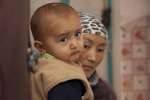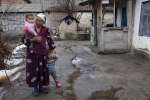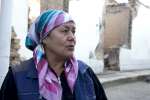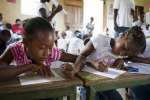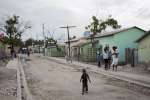The State of The World's Refugees 2000: Fifty Years of Humanitarian Action
State of the World's Refugees, 1 January 2000
UNHCR began as a small organization, with a three-year mandate to help resettle European refugees who were still homeless in the aftermath of the Second World War. Since that time, the organization has continually expanded to meet the growing needs of refugees and other displaced people.
The State of the World's Refugees 2000 provides a detailed history of half a century of international humanitarian action on behalf of refugees and other displaced people, covering all the major refugee emergencies of the last 50 years. It examines the way in which each succeeding crisis has helped shape an expanding body of refugee law, and it analyses the international community's changing response to the problem of forced migration. Above all, it places humanitarian action in the broader political context and examines the fundamental link between displacement and international peace and security.
UNHCR advocates fair and efficient procedures for asylum-seekers

All in the same boat: The challenges of mixed migration around the world.
The protection of millions of uprooted or stateless people is UNHCR's core mandate.
Numbers are important in the aid business and UNHCR's statisticians monitor them daily.
Millions of stateless people are left in a legal limbo, with limited basic rights.
Governments resolve and prevent statelessness by taking practical steps as set out in the Global Action Plan.
The two UN statelessness conventions are the key legal instruments in the protection of stateless people around the world.
Action taken by states, including follow-up on pledges made at UNHCR's 2011 ministerial meeting in Geneva.

Sign and share our Open Letter to End Statelessness by 2024.
Summary Conclusions of the first Global Roundtable on Alternatives to Detention, held in May 2011 in Geneva
A Commentary by Nehemiah Robinson of the Institute of Jewish Affairs at the 1955 World Jewish Congress, re-printed by UNHCR's Division of International Protection in 1997
Edited by Erika Feller, Volker Türk and Frances Nicholson, published 2003 by Cambridge University Press
The State of the World's Refugees
These six editions of UNHCR's The State of the World's Refugees provide detailed, in-depth analysis of the plight of the world's millions of displaced people. The authors examine the major crises and challenges faced by UNHCR for over fifty years.
Voluntary repatriation, local integration, resettlement, the three key solutions.
Teaching About Refugees, History
History includes refugees
Throughout history, political turmoil has victimized many civilian families, forcing them to flee their homes. Refugee outflows and other massive displacements of people are a key aspect of many international crises. For children, in particular, looking at world events from the point of view of a refugee family can give new meaning and a sense of reality to events that may otherwise seem abstract and far away. The theme can be introduced in:
Medieval/early modern history: The religious wars.
Contemporary history: World War I, the Russian Revolution, the collapse of the Ottoman Empire, the Second World War and Nazism, colonization and decolonization in Africa, Soviet influence in Central and Eastern Europe, the Arab-Israeli conflict, the Vietnam War, the dictatorships in Latin-America - all these events and many more have victimized millions of people and forced them to flee their homes, families and communities.
| 9-11 year olds |
Refugees in History
|
| 12-14 year olds |
The Rwandan Crisis 1994
|
| 15-18 year olds |
Population Displacement in the Commonwealth of Independent States
|
Studying history can provide an opportunity to examine refugee outflows and displacement.
From life-saving aid to help with shelter, health, water, education and more.
The internally displaced seek safety in other parts of their country, where they need help.
Related Internet Links
UNHCR is not responsible for the content and availability of external internet sites
Statelessness Around the World
At least 10 million people in the world today are stateless. They are told that they don't belong anywhere. They are denied a nationality. And without one, they are denied their basic rights. From the moment they are born they are deprived of not only citizenship but, in many cases, even documentation of their birth. Many struggle throughout their lives with limited or no access to education, health care, employment, freedom of movement or sense of security. Many are unable to marry, while some people choose not to have children just to avoid passing on the stigma of statelessness. Even at the end of their lives, many stateless people are denied the dignity of a death certificate and proper burial.
The human impact of statelessness is tremendous. Generations and entire communities can be affected. But, with political will, statelessness is relatively easy to resolve. Thanks to government action, more than 4 million stateless people acquired a nationality between 2003 and 2013 or had their nationality confirmed. Between 2004 and 2014, twelve countries took steps to remove gender discrimination from their nationality laws - action that is vital to ensuring children are not left stateless if their fathers are stateless or unable to confer their nationality. Between 2011 and 2014, there were 42 accessions to the two statelessness conventions - indication of a growing consensus on the need to tackle statelessness. UNHCR's 10-year Campaign to End Statelessness seeks to give impetus to this. The campaign calls on states to take 10 actions that would bring a definitive end to this problem and the suffering it causes.
These images are available for use only to illustrate articles related to UNHCR statelessness campaign. They are not available for archiving, resale, redistribution, syndication or third party licensing, but only for one-time print/online usage. All images must be properly credited UNHCR/photographer's name
Statelessness Around the World
Statelessness in Kyrgyzstan
Two decades after the disintegration of the Soviet Union, thousands of people in former Soviet republics like Kyrgyzstan are still facing problems with citizenship. UNHCR has identified more than 20,000 stateless people in the Central Asian nation. These people are not considered as nationals under the laws of any country. While many in principle fall under the Kyrgyz citizenship law, they have not been confirmed as nationals under the existing procedures.
Most of the stateless people in Kyrgyzstan have lived there for many years, have close family links in the country and are culturally and socially well-integrated. But because they lack citizenship documents, these folk are often unable to do the things that most people take for granted, including registering a marriage or the birth of a child, travelling within Kyrgyzstan and overseas, receiving pensions or social allowances or owning property. The stateless are more vulnerable to economic hardship, prone to higher unemployment and do not enjoy full access to education and medical services.
Since independence in 1991, Kyrgyzstan has taken many positive steps to reduce and prevent statelessness. And UNHCR, under its statelessness mandate, has been assisting the country by providing advice on legislation and practices as well as giving technical assistance to those charged with solving citizenship problems. The refugee agency's NGO partners provide legal counselling to stateless people and assist them in their applications for citizenship.
However, statelessness in Kyrgyzstan is complex and thousands of people, mainly women and children, still face legal, administrative and financial hurdles when seeking to confirm or acquire citizenship. In 2009, with the encouragement of UNHCR, the government adopted a national action plan to prevent and reduce statelessness. In 2011, the refugee agency will help revise the plan and take concrete steps to implement it. A concerted effort by all stakeholders is needed so that statelessness does not become a lingering problem for future generations.
Statelessness in Kyrgyzstan
Statelessness in the Dominican Republic
In the Dominican Republic, UNHCR runs programmes that benefit refugees and asylum-seekers from Haiti as well as migrants and members of their family born in the country, some of whom could be stateless or at risk of becoming stateless. Many live in bateyes, which are destitute communities on once thriving sugar cane plantations. The inhabitants have been crossing over from Haiti for decades to work in the sugar trade.
Among these initiatives, UNHCR provides legal aid, academic remedial courses and vocational training for refugees and asylum-seekers. They also support entrepreneurial initiatives and access to micro credit.
UNHCR also has an increased presence in border communities in order to promote peaceful coexistence between Dominican and Haitian populations. The UN refugee agency has found that strengthening the agricultural production capacities of both groups promotes integration and mitigates tension.
Many Haitians and Dominicans living in the dilapidated bateyes are at risk of statelessness. Stateless people are not considered as nationals by any country. This can result in them having trouble accessing and exercising basic rights, including education and medical care as well as employment, travel and housing. UNHCR aims to combat statelessness by facilitating the issuance of birth certificates for people living in the bateyes.
Statelessness in the Dominican Republic


Displaced: Root Causes
The High Commissioner's Dialogue, a two day conference will consider the root causes, war, natural hazards, persecution, statelessness, for the unprecedented number of displaced people around the world.


Greece: Ramping up refugee reception
UNHCR staff are working with Government authorities, NGOs and volunteers on the beaches of the Greek island of Lesvos to receive cold, wet and fearful asylum seekers making landfall around the clock. They wrap them in thermal blankets and take them to warm, safe emergency accommodation at transit sites, with power and Wi-Fi connectivity.


How Climate Change Impacts Human Displacement
As representatives from 190 countries head to Paris for the UN Climate Change Conference, UNHCR's top international protection expert explains how global warming impacts human displacement and what he hopes to come from the meeting.
 |
|  |
|  |
| 














